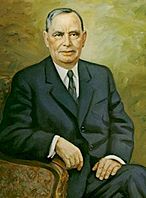United States House of Representatives elections, 1954
|
|
||||||||||||||||||||||||||||||||||
|---|---|---|---|---|---|---|---|---|---|---|---|---|---|---|---|---|---|---|---|---|---|---|---|---|---|---|---|---|---|---|---|---|---|---|
|
||||||||||||||||||||||||||||||||||
|
All 435 seats to the United States House of Representatives 218 seats were needed for a majority |
||||||||||||||||||||||||||||||||||
|
||||||||||||||||||||||||||||||||||
|
||||||||||||||||||||||||||||||||||
The 1954 United States House of Representatives elections was an election for the United States House of Representatives in 1954 which occurred in the middle of President Dwight Eisenhower's first term. Eisenhower's Republican Party lost eighteen seats in the House, giving the Democratic Party a majority that it would retain in every House election until 1994.
Perhaps the major reason for the Republican defeat was the fallout from the Army-McCarthy Hearings, in which prominent Republican Senator Joe McCarthy accused countless political and intellectual figures of having Communist ties, usually with no evidence. Another issue was the Dixon-Yates contract to supply power to the Atomic Energy Commission.
Sam Rayburn of Texas became Speaker of the House, exchanging places with new Minority Leader Joseph W. Martin, Jr. of Massachusetts; they went back to what they were coming up to the 1952 U.S. House elections.
...
Wikipedia


